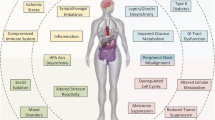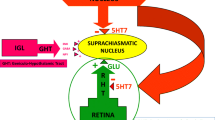Abstract
Purpose of Review
Technology and globalization have been central forces driving the need for shift work. This review examines recent scientific developments that inform our understanding of how psychological processes contribute to and are impacted by shift work.
Recent Findings
Nascent research is beginning to expand beyond circadian misalignment to elucidate the phenomenology of shift work and the associated psychological impairments. Psychological processes and their interaction with biology are considered in the pathophysiology of shift work sleep disorder. Additionally, a review of the adverse consequences of shift work in the cognitive, emotional, and psychosocial domains are reviewed and discussed.
Summary
The phenomenology of shift work encompasses multiple domains of biopsychosocial functioning. As such, interventions to reduce the adverse impact of shift work may benefit from an integrated approach.
Similar content being viewed by others
References
Papers of particular interest, published recently, have been highlighted as: • Of importance: •• Of major importance
Boivin DB, Boudreau P. Impacts of shift work on sleep and circadian rhythms. Pathol Biol. 2014;62:292–301.
Parent-Thirion A, Vermeylen G, van Houten G, Lyly-Yrjänäinen M, Biletta I, Cabrita J. Fifth European survey on working conditions. 2014.
Barnes M. Making time use explicit in an investigation of social exclusion in the UK. RES-061-23-0122. Swindon: ESRC; 2011.
Kerkhof GA. Shift work and sleep disorder comorbidity tend to go hand in hand. Chronobiol Int. 2017;35:1–10. https://doi.org/10.1080/07420528.2017.1392552.
Ferri P, Guadi M, Marcheselli L, Balduzzi S, Magnani D, Di Lorenzo R. The impact of shift work on the psychological and physical health of nurses in a general hospital: a comparison between rotating night shifts and day shifts. Risk Manag Healthc Policy. 2016;9:203–11.
American Academy of Sleep Medicine. The international classification of sleep disorders: diagnostic and coding manual. 2014.
• Kalmbach DA, Pillai V, Cheng P, Arnedt JT, Drake CL. Shift work disorder, depression, and anxiety in the transition to rotating shifts: the role of sleep reactivity. Sleep Med. 2015;16:1532–8. Selected because it uses a longitudinal approach to demonstrate that psychological factors such as sleep reactivity and stress predict shift work sleep disorder. This paper suggests that factors other than circadian misalignment should be considered in shift work.
Drake CL, Friedman NP, Wright KP, Roth T. Sleep reactivity and insomnia: genetic and environmental influences. Sleep. 2011;34:1179–88. https://doi.org/10.5665/sleep.1234.
Drake CL, Pillai V, Roth T. Stress and sleep reactivity: a prospective investigation of the stress-diathesis model of insomnia. Sleep. 2014;37:1295–304. https://doi.org/10.5665/sleep.3916.
Drake CL, Richardson G, Roehrs T, Scofield H, Roth T. Vulnerability to stress-related sleep disturbance and hyperarousal. Sleep. 2004;27:285–92.
Fernandez-Mendoza J, Shaffer ML, Olavarrieta-Bernardino S, Vgontzas AN, Calhoun SL, Bixler EO, et al. Cognitive–emotional hyperarousal in the offspring of parents vulnerable to insomnia: a nuclear family study. J Sleep Res. 2014;23:489–98. https://doi.org/10.1111/jsr.12168.
Dijk DJ, Archer SN. PERIOD3, circadian phenotypes, and sleep homeostasis. Sleep Med Rev. 2010;14:151–60. https://doi.org/10.1016/j.smrv.2009.07.002.
Archer SN, Robilliard DL, Skene DJ, Smits M, Williams A, Arendt J, et al. A length polymorphism in the circadian clock gene Per3 is linked to delayed sleep phase syndrome and extreme diurnal preference. Sleep. 2003;26:413–5.
Gallego M, Virshup DM. Post-translational modifications regulate the ticking of the circadian clock. Nat Rev Mol Cell Biol. 2007;8:139–48. https://doi.org/10.1038/nrm2106.
Archer SN, Schmidt C, Vandewalle G, Dijk D-J. Phenotyping of PER3 variants reveals widespread effects on circadian preference, sleep regulation, and health. Sleep Med Rev. 2017; https://doi.org/10.1016/j.smrv.2017.10.008.
Drake CL, Belcher R, Howard R, Roth T, Levin AM, Gumenyuk V. Length polymorphism in the Period 3 gene is associated with sleepiness and maladaptive circadian phase in night-shift workers. J Sleep Res. 2015;24:254–61.
Cheng P, Tallent G, Burgess H, Tran KM, Roth T, Drake CL. Daytime sleep disturbance in night shift work: the role of PERIOD3? J Clin Sleep Med. 2018;14:393–400.
Graw P, Kräuchi K, Knoblauch V, Wirz-Justice A, Cajochen C. Circadian and wake-dependent modulation of fastest and slowest reaction times during the psychomotor vigilance task. Physiol Behav. 2004;80:695–701.
Horowitz TS, Cade BE, Wolfe JM, Czeisler CA. Searching night and day: a dissociation of effects of circadian phase and time awake on visual selective attention and vigilance. Psychol Sci. 2003;14:549–57. https://doi.org/10.1046/j.0956-7976.2003.psci_1464.x.
Van Dongen H, Dinges DF. Sleep, circadian rhythms, and psychomotor vigilance. Clin Sports Med. 2005;24:237–49.
Kaliyaperumal D, Elango Y, Alagesan M, Santhanakrishanan I. Effects of sleep deprivation on the cognitive performance of nurses working in shift. J Clin Diagn Res JCDR. 2017;11:CC01.
Cheng P, Tallent G, Bender TJ, Tran KM, Drake CL. Shift work and cognitive flexibility: decomposing task performance. J Biol Rhythm. 2017;32:143–53.
Belcher R, Gumenyuk V, Roth T. Insomnia in shift work disorder relates to occupational and neurophysiological impairment. J Clin Sleep Med JCSM Off Publ Am Acad Sleep Med 2015;11:457–465. https://doi.org/10.5664/jcsm.4606.
Gumenyuk V, Roth T, Korzyukov O, Jefferson C, Kick A, Spear L, et al. Shift work sleep disorder is associated with an attenuated brain response of sensory memory and an increased brain response to novelty: an ERP study. Sleep. 2010;33:703–13.
US Chemical Safety Board. Refinery explosion and fire. Washington, DC: 2007.
•• Marquié J-C, Tucker P, Folkard S, Gentil C, Ansiau D. Chronic effects of shift work on cognition: findings from the VISAT longitudinal study. Occup Environ Med 2014:oemed–2013. Selected because of its unique contribution to the understanding of the long-term trajectory of recovery from shift work.
Monk T, Buysse D, Reynolds Iii C, Berga S, Jarrett D, Begley A, et al. Circadian rhythms in human performance and mood under constant conditions. J Sleep Res. 1997;6:9–18. https://doi.org/10.1046/j.1365-2869.1997.00023.x.
McClung CA. Circadian genes, rhythms and the biology of mood disorders. Pharmacol Ther. 2007;114:222–32. https://doi.org/10.1016/j.pharmthera.2007.02.003.
Chenu F, Mansari ME, Blier P. Electrophysiological effects of repeated administration of agomelatine on the dopamine, norepinephrine, and serotonin systems in the rat brain. Neuropsychopharmacology. 2013;38:275–84. https://doi.org/10.1038/npp.2012.140.
Etain B, Milhiet V, Bellivier F, Leboyer M. Genetics of circadian rhythms and mood spectrum disorders. Eur Neuropsychopharmacol. 2011;21:S676–82. https://doi.org/10.1016/j.euroneuro.2011.07.007.
Roybal K, Theobold D, Graham A, DiNieri JA, Russo SJ, Krishnan V, et al. Mania-like behavior induced by disruption of CLOCK. Proc Natl Acad Sci. 2007;104:6406–11. https://doi.org/10.1073/pnas.0609625104.
Soria V, Martínez-Amorós È, Escaramís G, Valero J, Pérez-Egea R, García C, et al. Differential association of circadian genes with mood disorders: CRY1 and NPAS2 are associated with unipolar major depression and CLOCK and VIP with bipolar disorder. Neuropsychopharmacology. 2010;35:1279–89.
Lavebratt C, Sjöholm LK, Soronen P, Paunio T, Vawter MP, Bunney WE, et al. CRY2 is associated with depression. PLoS One. 2010;5:e9407.
Terracciano A, Tanaka T, Sutin AR, Sanna S, Deiana B, Lai S, et al. Genome-wide association scan of trait depression. Biol Psychiatry. 2010;68:811–7.
Lavebratt C, Sjöholm LK, Partonen T, Schalling M, Forsell Y. PER2 variantion is associated with depression vulnerability. Am J Med Genet B Neuropsychiatr Genet. 2010;153:570–81.
Galecki P, Szemraj J, Bartosz G, Bieńkiewicz M, Galecka E, Florkowski A, et al. Single-nucleotide polymorphisms and mRNA expression for melatonin synthesis rate-limiting enzyme in recurrent depressive disorder. J Pineal Res. 2010;48:311–7.
Galecka E, Szemraj J, Florkowski A, Galecki P, Bieńkiewicz M, Karbownik-Lewińska M, et al. Single nucleotide polymorphisms and mRNA expression for melatonin MT2 receptor in depression. Psychiatry Res. 2011;189:472–4.
Books C, Coody LC, Kauffman R, Abraham S. Night shift work and its health effects on nurses. Health Care Manag. 2017;36:347–53. https://doi.org/10.1097/HCM.0000000000000177.
• Angerer P, Schmook R, Elfantel I, Li J. Night work and the risk of depression. Dtsch Arzteblatt Int. 2017;114:404–11. https://doi.org/10.3238/arztebl.2017.0404. This systematic review was selected for its synthesis of the latest research on how night work impacts depression.
Bildt C, Michélsen H. Gender differences in the effects from working conditions on mental health: a 4-year follow-up. Int Arch Occup Environ Health. 2002;75:252–8.
Driesen K, Jansen NWH, van Amelsvoort LGPM, Kant I. The mutual relationship between shift work and depressive complaints—a prospective cohort study. Scand J Work Environ Health Stockh 2011;37:402–410.
Nabe-nielsen K, Garde AH, Albertsen K, Diderichsen F. The moderating effect of work-time influence on the effect of shift work: a prospective cohort study. Int Arch Occup Environ Health Heidelb. 2011;84:551–9. https://doi.org/10.1007/s00420-010-0592-5.
Aldous J. Occupational characteristics and males’ role performance in the family. J Marriage Fam. 1969;31:707–12. https://doi.org/10.2307/349312.
Jensen HI, Larsen JW, Thomsen TD. The impact of shift work on intensive care nurses’ lives outside work: a cross-sectional study. J Clin Nurs 2017:n/a-n/a. https://doi.org/10.1111/jocn.14197.
Hawthorne G. Perceived social isolation in a community sample: its prevalence and correlates with aspects of peoples’ lives. Soc Psychiatry Psychiatr Epidemiol. 2008;43:140–50. https://doi.org/10.1007/s00127-007-0279-8.
Becker L, Barnes M. Understanding participatory time for groups at risk of social exclusion, 2009.
Author information
Authors and Affiliations
Corresponding author
Ethics declarations
Conflict of Interest
Philip Cheng and Christopher L Drake declare no conflicts of interest.
Human and Animal Rights and Informed Consent
This article does contain studies with human subjects performed by any of the authors.
Additional information
This article is part of the Topical Collection on Sleep and Psychological Disorders
Rights and permissions
About this article
Cite this article
Cheng, P., Drake, C.L. Psychological Impact of Shift Work. Curr Sleep Medicine Rep 4, 104–109 (2018). https://doi.org/10.1007/s40675-018-0114-7
Published:
Issue Date:
DOI: https://doi.org/10.1007/s40675-018-0114-7




